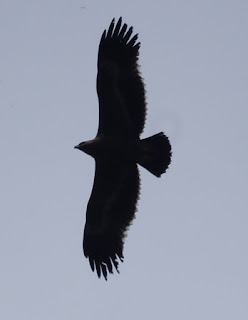Nepal is great for birds of prey. They fly past so close.
During the trip we saw both Red and Yellow-billed Magpies in good numbers but at different altitudes. Impressive and noisy birds.
We also saw a number of woodpeckers, the most common being Darjeeling Woodpecker. This is a female.
There were good numbers of flycatchers around but this Rufous-bellied Niltava gave stunning views.
Surya was our host and he was totally awesome. A more kind and generous person it would be hard to find. He gave up his time to join us on the trek and made sure we were all safe and well. Thanks Surya, you are a star and we owe you one!
Back to the Niltava theme. This one is a Small Niltava.
The Nepal House Martin showed in large numbers as we dropped down from the mountains. Their dark underwings and throats make them rather distinctive. The white rump patch is pretty big too.
Yet another Greenfinch. This one is a Yellow-breasted Greenfinch.

Loads of Rosefinch in the fields.
Good numbers of Steppe Eagle as well.
A close view of a Lammergeier as it flew over us.
I think this is a Lanner falcon. Any thoughts?
We stopped for our last night of the trek at this great hotel run by Surya's extended family. He took me for a tour round the village to see some great birds near the school, before taking me to his family home that his uncle and aunt now own. The uncle served in the Gurka's but has been retired for many years. He did not look his age of 80+!
This is a Red-billed Magpie which is found at lower levels than its Yellow-billed cousin.
So that was our trek finished and it had been fantastic. I'd recommend it to anyone although it was made very special by Surya's local knowledge and our excellent porter who became more and more interested in birds as the trek went on, walking out every morning and evening to locate them when he could have been drinking tea back at base. We also discovered he had a great eye for finding them. I was constantly amazed at how the locals carried heavy loads lashed to their foreheads often only wearing flipflops on their feet as they negotiated the rocky paths.
We returned to Pokhara and the following day Surya took us on a trip around the local area, crossing the lake on a boat before climbing through the woods to the Peace Pagoda. Whilst we were at the top, there was a small fall of raptors which passed really close as we drank our tea. There were three species of Vulture, a number of Steppe Eagle and some Buzzard. In total fifty or so in about an hour.
Adult Egyptian Vulture
Snap hats, a present from Surya. Thanks for everything.
The next day we made the buttock clenching journey back to Kathmandu. The road passes through beautiful scenary but the overtaking around blind corners takes a bit of adjustment. After five hours we arrived at our hotel for the next few days. It was on the edge of the city, up against a nature reserve and run by two french women called Pauline. It was a touch of paradise in a superb location with fabulous food.
The birding was interesting but mainly good views of birds I had seen already. However, I was pleased to catch up with this Spotted Forktail.
The centre of Katmandu is a fascinating city. It has an ancient feel as many buildings seem unchanged for hundreds of years. Religious artifacts appear round every corner and the roads away from the main ones are unmade. The streets are narrow and feel almost Elizabethan as you step down through small doorways in to cramped shops.
It was New Year celebrations and as we walked around the city, musiic and processions were everywhere. I hope this video works.















































